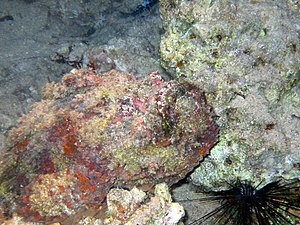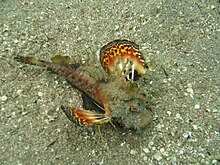Stone fish
| Stone fish | ||||||||||||
|---|---|---|---|---|---|---|---|---|---|---|---|---|

Arabian stonefish ( Synanceia nana ) |
||||||||||||
| Systematics | ||||||||||||
|
||||||||||||
| Scientific name | ||||||||||||
| Synanceiidae | ||||||||||||
| Kaup , 1873 |
The stonefish (Synanceiidae) are a family of marine fish from the order of the perch-like (Perciformes). They are best known for the fact that some of their species are among the most poisonous fish of all. The poison that sits in the dorsal fin spines is extremely painful and can also be fatal for humans. They live in the tropical Indo-Pacific and the Red Sea.
Features and dangers
Stonefish are 8 to 60 cm long, depending on the species, have a plump or elongated body, large pectoral fins , a very large, flattened head and an upward, large mouth. The skin is bare, with warty glands, rough and often overgrown with algae. The bone ridge on the head sides ("armored cheeks") extends to the gill cover . At the Lachrimale , stonefish have a saber-like bone, the teardrop , which they can use as a defensive weapon. To do this, it is moved to the side from its resting position on the underside of the Laughrimal to a locked position.
- Fins formula : dorsal XI – XVII / 4–14, anal II – IV / 4–14, ventral I / 3–5, pectoral 10–11
- Vertebrae: 23-30.
In glands at the base of the dorsal fin spines a variety of a mixture is proteins existing neurotoxin produced, one of the most dangerous venoms and can be fatal for people sometimes, there's this, however, hardly any significant statistics.
The sting of a stone fish usually leads to extreme pain in the puncture site. Even the strongest analgesics like fentanyl usually have no effect. Some sources also mention overflows with hot water, which can have a soothing effect, but also involve the risk of scalding. Some sources mention successful treatment with the local anesthetic lidocaine and benzodiazepines. There is also an antidote.
Way of life
Stonefish live as solitary bottom dwellers, mostly camouflaged as rocks, in relatively shallow water in coral and rock reefs , on sandy, scree and soft bottoms. Some species also go into estuaries. As fixed, excellently camouflaged ambulance hunters, they feed on small fish, cephalopods and crustaceans , which they suck in by suddenly opening their mouths. The animals are bad swimmers. Their larvae are pelagic .
Systematics
Nelson (2006) places the stone fish as a subfamily of the scorpion fish (Scorpaenidae). Other authors, like Nelson in the 1994 edition of his standard work on fish systematics, see them as an independent family.
After the phylogenetic study of Smith and Wheeler, the stone fish are clearly outside the scorpion fish and form with the Stirnflossern (Tetraroginae), the Samtfischen (Aploactinidae) and the Indians fish (Pataecidae) a hitherto unknown quantity monophyletic taxon . The close relationship of the four taxa is not only supported by molecular biological data, but also by the morphology of the fish larvae, the adult animals and the similar way of life as well camouflaged lurker hunters of tropical flat seas.
There are 36 species in nine genera and three subfamilies.

-
Stonefish (Synanceidae)
- Subfamily devil fish (Choridactylinae)
- Choridactylus Richardson, 1848
- Inimicus Jordan & Starks, 1904
- Subfamily Minoinae
- Stingfish ( Minous ) Cuvier in Cuvier & Valenciennes, 1829
- Subfamily Steinfische i. e. S. (Synanceiinae)
- Dampierosa Whitley, 1932
- Erosa Swainson, 1839
- Leptosynanceia Bleeker, 1874
- Pseudosynanceia Day, 1875
- Synanceia Bloch & Schneider, 1801
- Trachicephalus Swainson, 1839
- Subfamily devil fish (Choridactylinae)
literature
- Joseph S. Nelson : Fishes of the World . John Wiley & Sons, 2006, ISBN 0-471-25031-7
- Kurt Fiedler: Textbook of Special Zoology, Volume II, Part 2: Fish . Gustav Fischer Verlag Jena, 1991, ISBN 3-334-00339-6
Individual evidence
- ↑ Smith, WL, Everman, E. & Richardson, C. (2018): Phylogeny and Taxonomy of Flatheads, Scorpionfishes, Sea Robins, and Stonefishes (Percomorpha: Scorpaeniformes) and the Evolution of the Lachrymal Saber. Copeia 106 (1): 94-119. 2018 doi: 10.1643 / CG-17-669
- ↑ Stonefish causes pain. Retrieved April 3, 2020 .
- ^ William Leo Smith and Ward C. Wheeler: Polyphyly of the mail-cheeked fishes (Teleostei: Scorpaeniformes): evidence from mitochondrial and nuclear sequence data. In: Molecular Phylogenetics and Evolution. 32, 2004, p. 627, doi : 10.1016 / j.ympev.2004.02.006 .
Web links
- Stonefish on Fishbase.org (English)
